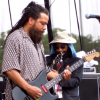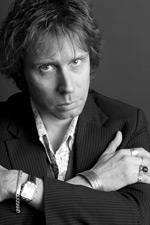One early evening in the fall of 1981, I put on the leather jacket I had worked all summer bagging groceries to buy, met up with the two other punks in my suburban New Jersey high school, and got on a bus headed into New York City. I was excited and nervous. It was my first trip to CBGB, the infamous incubator of punk rock itself. Serious business.
The bill that night was a handful of young bands playing a much faster, tougher variant of the sound mapped out by the music’s mid-’70s pioneers, a new style with a new name: hardcore punk. The headliner? A recently transplanted quartet from Washington, DC, that my buddies and I were only slightly familiar with—the Bad Brains.
If you never made it to the now-gone landmark, CBGB was a narrow, dark, dank sweatbox that stank of stale beer, urine, and marijuana resin. Its walls were encrusted with layer upon layer of stickers, gig flyers, and spray-painted and magic-markered graffiti. Its floors were sticky, its door people and bartenders non-smiling, unfeeling seen-it-alls who had absolutely zero time for peach-fuzzed corndogs like me and my companions. And it had the best sound system of any rock club in the city; towering, custom-built speaker stacks that pumped out tsunamis of bone-crushing decibels. I fell in love with the place.
After sets by three or four enjoyable but very much of-the-time bands, the crucial moment arrived. The Bad Brains’ guitarist, followed by the likewise dreadlocked drummer and bassist, walked on stage, plugged in, and tested his amp with one mighty, room-rattling E chord. I will never forget that chord. It told me that everything I thought about rock ‘n’ roll was about to change. Very soon.
The singer, a wiry, gap-toothed dude with the wildest dreads of the bunch sauntered on like a panther. The band eased into a jazzy flourish more like something from a hotel lounge than a punk club. Smiling and greeting his “friends,” he flopped like a rag doll into the audience, which passed him around and returned him gently to the bandstand.
Then it all stopped.
The drummer went into a tight roll on his snare, picking up speed like a coin falling on a concrete floor. He cut it off—cold. And, then, with no cue or count-in, the universe exploded.
A wave of frenetic, mountain-plowing locomotion engulfed me. Bodies were immediately flying everywhere, careening off the walls and each other as the monolithic roar dominated everything. And, in the middle of it all, the tornado in the eye of the hurricane, was the whirling, possessed vocalist, snarling, shrieking, and moaning, with the fiery eyes of a preacher. I have seen many great live rock ’n’ roll bands in the nearly 25 years since that night. But none of them have been able to touch 1980s Bad Brains. Not even close.
Besides being an all-black band in an overwhelmingly white scene, there have always been several other aspects setting the group apart: the superhuman velocity of their sound; the jaw-dropping precision of their musicianship; the way they pepper their raging sets with consoling reggae. But there’s also something else, something far bigger, at work. The Bad Brains are punk mystics. It’s one of those things that can be felt much easier than explained, but the deeply spiritual art of this quartet burns with an inner mounting flame more common to the music of Ravi Shankar, John Coltrane, or Native American elders than with rock ‘n’ roll.
Much of this magic fire can be linked directly to an unlikely source: Think and Grow Rich by Napoleon Hill. The book is an early self-help classic that the band—guitarist Dr. Know (aka Gary Miller), bassist Daryl Jenifer, drummer Earl Hudson, and vocalist H.R. (aka Paul Hudson, Earl’s brother; his initials have stood for both Huntin’ Rod and Human Rights)—took as its bible, substituting goals of artistic and personal success for the work’s stated aim of guiding readers to monetary wealth. Central to Hill’s teachings is the concept of Positive Mental Attitude—or PMA—a philosophy that has kept the band’s eyes on the prize through thick and thin throughout its nearly three decades.
“PMA has helped us maintain the conviction of what we intended to do when we started out,” says Jenifer. “Which was to be the greatest punk rock band of all.”
The Bad Brains began in 1977 as Mind Power, a group playing not punk, but jazz-funk fusion. Wasn’t such technique-centric lineage a no-no for back-to-basics punk rockers?
“Not to us,” says Jenifer. “We were blessed with the versatility. DC is the home of go-go music, which is what most people there expected a black band to be doin’. We liked that music, too, but we still wanted to be different. So it was a blessing and a curse to be in the middle of all that.”
A friend and early band member turned the others onto punk, playing them records by the Ramones, Sex Pistols, Dead Boys, and others. Taking its new name from a Ramones song, the group moved onto club dates but was shut out of nearly every local venue, thanks to the sometimes violent reactions of its audience. After discovering reggae via UK punks the Clash and the Slits, the four members converted to Rastafari and headed for New York in 1981.
There, they became the new prime movers of the nascent Big Apple hardcore scene, drawing well at CBGB and Irving Plaza and inspiring dozens of younger bands. In late ’81 the group released its galvanizing, self-titled debut and began touring relentlessly, catching the ear of The Cars’ Ric Ocasek, who produced the follow-up, 1983’s Rock for Light.
After the first of many hiatuses, the group reconvened in 1986 to record its masterpiece, I Against I. A thunderous, ground-shaking set melding punk with dub and hard rock, the album showcases H.R.’s chameleon-like vocal talents as he darts between a deep baritone, rapid-fire rap, and his signature otherworldly falsetto.
The album won the foursome heaps of critical praise and a new generation of fans. Major labels began sniffing around. But another piece of Bad Brains lore has it that commercial defeat will frequently be snatched from the jaws of victory. While he’s a riveting, shamanistic front man, cannons don’t come much looser than H.R., whose legendary instability has alienated many potential allies and helped quash several big-label deals.
“Like most genius artists, the Bad Brains are flawed when it comes to other [non-artistic] areas,” says Steve Blush, author of American Hardcore: A Tribal History and co-producer of the new documentary American Hardcore (Sony Classics), in which the band features heavily. “They have a history of constant business problems, of all the wrong things happening at the wrong times.” He points to H.R. famously walking out on a deal with Island records in 1985.
Jenifer moved his family to Woodstock in 1984. “The Great Spirit showed me I could get a nice, big place up here for what I was paying for my apartment in Brooklyn,” he says. “Even when I lived in the ‘hood, I always dug the woods.” Dr. Know followed him up the next year, while Earl went south to Atlanta. H.R. seems to be doing better now, but has struggled with mental health issues and frequently lived on the streets.
The Bad Brains are an acknowledged touchstone of platinum-harvesters like Rage Against the Machine, Living Color, and White Zombie. But does the band harbor any bitterness at those who have woven the threads of its sound into solid-gold success? “Nah,” says Jenifer with a smile and a shrug. “You know what they say: ‘Each one teach one.’”
The outfit’s combined soul is infinitely bigger than that of the individual players, and has always managed to corral them back together. Right now this spirit is manifesting itself in several fortuitous ways: a forthcoming album on Megaforce; a possible tour; the appearance in American Hardcore; a satellite radio show hosted by Jenifer; a DVD of 1982 CBGB performances; and three sold-out dates during the club’s final week.
So there I was, back at CB’s in early October for the first of those shows. Full circle. Shoehorned around me were kids holding blue-glowing cell phones, twenty-somethings who were nowhere near born that first time I came here. Still smelled the same, though. And the edificial PA was still kicking, resonating with chest-thumping dub classics. I was nervous and excited all over again. Would we catch lightning in a bottle once more?
Well, in a way. The band cooked as ferociously as ever, but H.R., wearing shades, a crash helmet, and a demented smile, was uncharacteristically immobile as he vocalized into a malfunctioning headphone mic. It wasn’t what I was hoping for, but maybe that wasn’t such a bad thing.
“H.R. ain’t no jukebox,” Jennifer says later. “The Bad Brains ain’t no philharmonic orchestra, son.
“I didn’t always get it, but I see what H.R. was doin’ now. He doesn’t wanna do the same thing every gig. He wants to make it more interesting for himself, more of a
challenge for the audience. Maybe that pisses some people off,” Jenifer pounds the bar top to punctuate his point. “But, hey, the man is punk rock. That’s how it is.”
To that end, while much of the glory-seeking audience is unsure what to make of the show, many in the room are bowled over by H.R.’s bemused, performance-art juxtaposition of Rasta benevolence against the group’s punk fury. And it’s clearly intentional, as all reports say the following two nights were classic, off-the-hook Bad Brains sets. “I wish you coulda caught the second night,” Jenifer says. “That was just perfect, man.”
So what was it, then, that the Bad Brains taught me about rock ’n’ roll? That’s easy, and it’s a lesson I took with me when I went onstage myself at CBGB, years after that first visit: Always go all out, always challenge yourself and your audience. But they also taught me some other things, things that have helped me in much bigger ways outside the finite sphere of rock: If one plan fails, try another; turn defeat into success. Always keep that PMA. And never, never give in, no matter what life brings.
I still have that jacket, by the way, hanging in my closet. It’s been through a lot and doesn’t fit me so well anymore. But somehow I couldn’t live without it. And I still like to take it out once in a while, if only to marvel at how well it was made.








